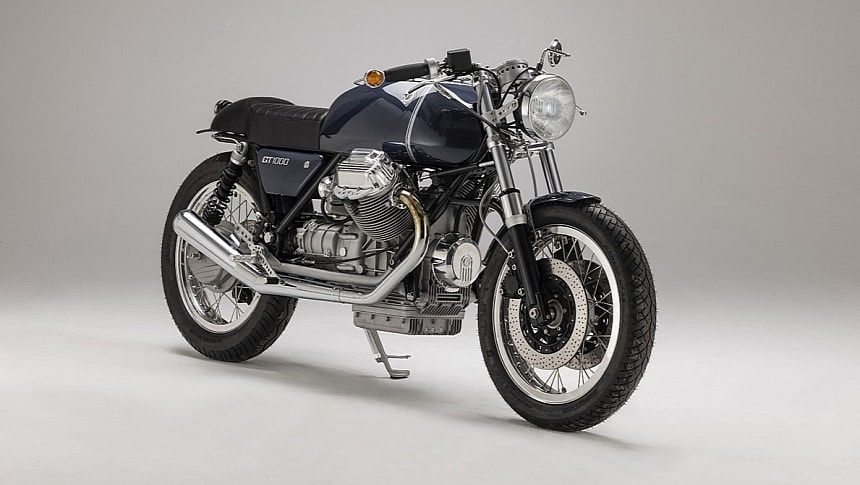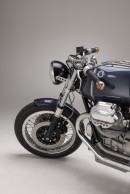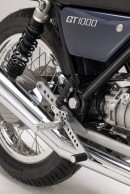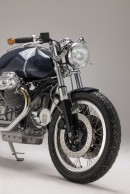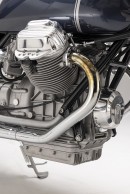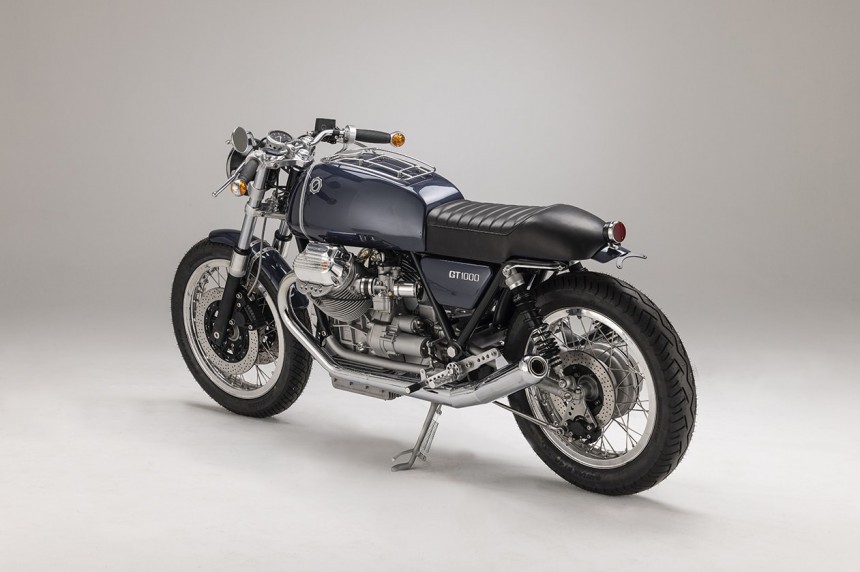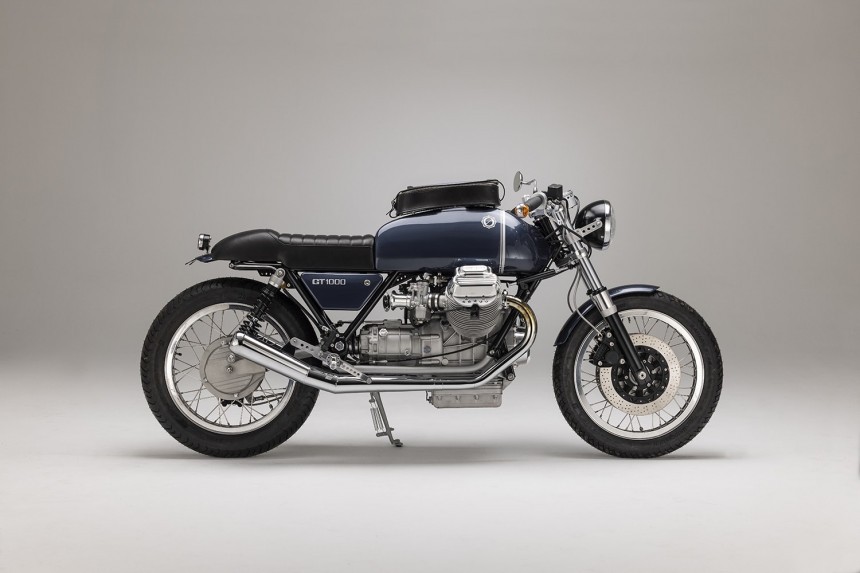Axel Budde is one of those custom bike builders that require no introduction whatsoever, because his work is known and praised by enthusiasts far and wide. Operating as Kaffeemaschine out of Hamburg, Germany, he’s developed a signature style that simply cannot be mistaken for anyone else’s. In short, there’s hardly anyone more qualified than Axel to give your Guzzi the custom treatment.
Indeed, the man deals solely with the Moto Guzzi marque under Kaffeemaschine’s banner, knowing his way around Mandello del Lario’s motorcycles like the back of his hand. Oh, and the workshop’s name should leave absolutely no room for interpretation regarding Axel’s favorite style. His mouth-watering cafe racers have been featured extensively on our site, never failing to make a big impression or leave us awestruck.
Although it still leans toward the cafe genre quite heavily, the bike we’ll be looking at today places great emphasis on practicality for longer rides. This particular build wasn’t commissioned by a client, but it was instead put together by Axel on his own terms to test out some ideas. His main goal was to add a nice bit of touring capability to the usual customization formula, and the result is truly fantastic by every metric.
The starting point for this conversion was a Le Mans II from the model-year 1980. Not one bit of this classic Guzzi has remained unchanged, though, because the Meister at Kaffeemaschine had big plans with it right from the start. After taking the donor apart, he deleted a large chunk of its factory hardware and proceeded to build a new subframe in-house.
Next up, his attention turned to the unsprung sector, where you will now find a pair of shouldered San Remo rims connected to stainless-steel spokes. The wheels are enveloped in Bridgestone Battlax BT-46 rubber for plentiful grip fore and aft, but that would mean nothing if the brakes weren’t up for the task. As such, these were upgraded with fresh drilled discs, Brembo master cylinders, and stainless-steel hoses all-round.
Our protagonist spared no expense in the suspension sector, either, treating the motorcycle’s front end to billet aluminum triple clamps and high-grade 40 mm (1.6-inch) forks. An aftermarket steering damper was thrown into the mix, too, so as to keep things nice and stable at high speeds. At the opposite end, suspension duties fall under the jurisdiction of twin adjustable shock absorbers sourced from Wilbers’ inventory.
The bits and pieces we’ve mentioned so far are all pretty cool, for sure, but the specimen’s new bodywork is no less intriguing. Each and every piece of it was fabricated using carbon fiber, with the goal of reducing weight as much as possible. Center-stage, we notice a handsome fuel tank able to store a decent amount of fuel, and it’s topped with a custom luggage rack made of thin stainless-steel tubing.
Bespke CFRP fenders are present at both ends, with the rear unit fitted in a manner so subtle that you can hardly spot it at all. Its rearmost tip does come out into full view, though, topped with a circular LED taillight and a minimalistic license plate bracket. The updated attire is finished off with custom side covers placed where the factory Le Mans II modules had once been.
They flank a thickly-padded saddle upholstered in premium Aniline leather, the same material used to create a stylish touring tank bag fit for the aforementioned rack. In the cockpit area, the Kaffeemaschine treatment brought about a low-profile, chromed handlebar with bar-end turn signals, billet switches, and a single rear-view mirror placed on the left. A Motogadget ChronoClassic dial is also located nearby, stored inside a custom metal housing.
Other bits worth mentioning on this creature are the CNC-machined rearsets and tailor-made mounting points for saddlebags or panniers. Oh, and then there are all the purposeful mods performed in the powertrain department, with the first thing to note being the V-twin's increased capacity. It now displaces 1,000cc and is capable of producing up to 85 hp.
On the inside, Axel installed goodies such as a replacement crankshaft, fresh valves, and an all-new cam, while also porting and polishing the cylinder heads. He fitted a modern electronic ignition system to take reliability one step further, and a pair of Dell’Orto PHF carbs are now part of the air intake. They’re capped off with custom velocity stacks made of billet aluminum, but then there is that stunning exhaust.
It was fashioned in Kaffeemaschine’s signature style out of stainless-steel, perfectly matched to the aesthetic characterizing the rest of this modded Le Mans II. Lastly, the bodywork was clad in a glossy layer of navy-blue paint topped with white highlights, whereas items like the frame, headlight bucket, and fork lowers were all finished in black. Bare metal and chrome plating are the name of the game elsewhere.
Although it still leans toward the cafe genre quite heavily, the bike we’ll be looking at today places great emphasis on practicality for longer rides. This particular build wasn’t commissioned by a client, but it was instead put together by Axel on his own terms to test out some ideas. His main goal was to add a nice bit of touring capability to the usual customization formula, and the result is truly fantastic by every metric.
The starting point for this conversion was a Le Mans II from the model-year 1980. Not one bit of this classic Guzzi has remained unchanged, though, because the Meister at Kaffeemaschine had big plans with it right from the start. After taking the donor apart, he deleted a large chunk of its factory hardware and proceeded to build a new subframe in-house.
Next up, his attention turned to the unsprung sector, where you will now find a pair of shouldered San Remo rims connected to stainless-steel spokes. The wheels are enveloped in Bridgestone Battlax BT-46 rubber for plentiful grip fore and aft, but that would mean nothing if the brakes weren’t up for the task. As such, these were upgraded with fresh drilled discs, Brembo master cylinders, and stainless-steel hoses all-round.
The bits and pieces we’ve mentioned so far are all pretty cool, for sure, but the specimen’s new bodywork is no less intriguing. Each and every piece of it was fabricated using carbon fiber, with the goal of reducing weight as much as possible. Center-stage, we notice a handsome fuel tank able to store a decent amount of fuel, and it’s topped with a custom luggage rack made of thin stainless-steel tubing.
Bespke CFRP fenders are present at both ends, with the rear unit fitted in a manner so subtle that you can hardly spot it at all. Its rearmost tip does come out into full view, though, topped with a circular LED taillight and a minimalistic license plate bracket. The updated attire is finished off with custom side covers placed where the factory Le Mans II modules had once been.
Other bits worth mentioning on this creature are the CNC-machined rearsets and tailor-made mounting points for saddlebags or panniers. Oh, and then there are all the purposeful mods performed in the powertrain department, with the first thing to note being the V-twin's increased capacity. It now displaces 1,000cc and is capable of producing up to 85 hp.
On the inside, Axel installed goodies such as a replacement crankshaft, fresh valves, and an all-new cam, while also porting and polishing the cylinder heads. He fitted a modern electronic ignition system to take reliability one step further, and a pair of Dell’Orto PHF carbs are now part of the air intake. They’re capped off with custom velocity stacks made of billet aluminum, but then there is that stunning exhaust.
It was fashioned in Kaffeemaschine’s signature style out of stainless-steel, perfectly matched to the aesthetic characterizing the rest of this modded Le Mans II. Lastly, the bodywork was clad in a glossy layer of navy-blue paint topped with white highlights, whereas items like the frame, headlight bucket, and fork lowers were all finished in black. Bare metal and chrome plating are the name of the game elsewhere.
